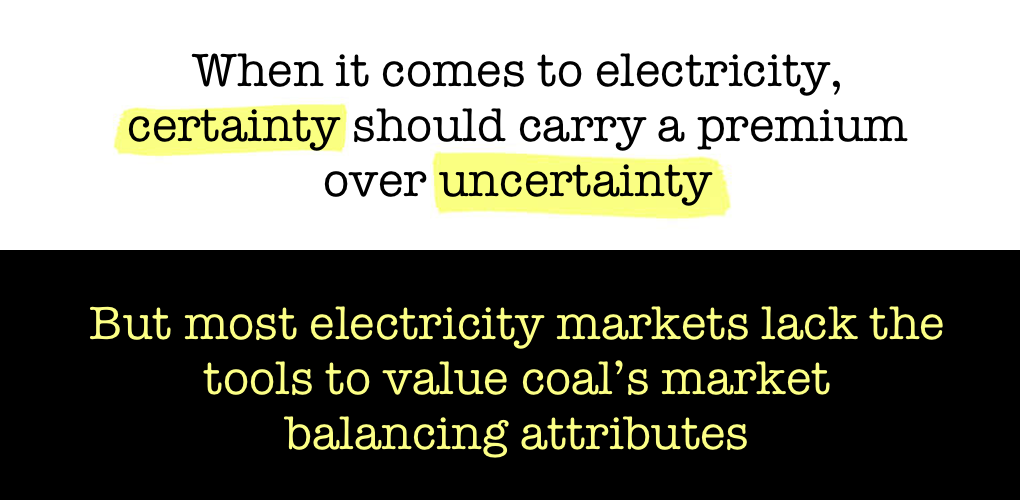
Markets Must Better Value Flexible, Dispatchable Coal Power
How valuable is a kilowatt hour of electricity? That, of course, depends greatly on when that electricity is produced and just how much it’s needed. Consider the gulf in value of excess electricity generated by solar power midday and the electricity produced by a coal plant when demand is spiking and intermittent sources of power are handcuffed by uncooperative weather. While the solar generation stresses the integrity of the grid, the power produced by the coal plant reinforces it.
When it comes to electricity, certainty should carry a premium over uncertainty. And yet, most electricity markets lack the tools to properly compensate coal’s market balancing attributes. It’s a problem now coming to a head – with huge affordability and reliability repercussions – as much of the remaining coal fleet is caught in an ugly catch-22.
As wind and solar penetration has grown in regional grids, many coal plants are no-longer running around-the-clock as designed. They are instead load-following, cycling their output up and down to accommodate the peaks and valleys of intermittent renewable generation. This increased cycling means these plants are running less but the wear and tear on them is increasing. At the very moment the cost of their maintenance and upkeep is rising, they’re selling less power. Their profitability is declining and like far too many coal plants before them, they are now teetering on the edge of early retirement.
While these plants should be compensated for the critical role they’re playing in shoring up supply, a new report prepared for the National Association of Regulatory Commissioners explains that they aren’t – and why that’s such a mistake.
The authors write, “No specific market mechanisms to compensate unit flexibility provided by fossil fuel power plants exist in the Electric Reliability Council of Texas (ERCOT) and Southwest Power Pool (SPP) power markets, the two independent system operators with the largest share of intermittent renewable energy resources in their generation mix.” They continue, “…more coal retirements due to poor economics are likely, increasing the risk of potential power outages in states like Texas.”
As the authors explain, building market mechanisms to compensate these plants for the value they’re providing would likely save consumers and ensure reliability: “Thoughtful market mechanisms that financially compensate coal-fired generating units for providing essential market balancing attributes, such as short-term generation flexibility, could arguably result in lower electric retail rates for end-use consumers while equally, if not more importantly, helping to ensure reliable operation of the nation’s electric power grid.”
The authors point to Texas and ERCOT’s near-miss with rolling blackouts this past summer to illustrate the urgency of the situation. “As the example in Texas this summer has shown, sufficient backup flexible capacity is needed to ensure reliable electricity supply during peak demand times, coupled with a higher-than-expected loss of variable generation from wind or solar. Without any other market mechanisms incentivizing new capacity entry into the market, keeping existing fossil generation from retiring becomes paramount.”
In other words, keeping these plants online, and finding a way to properly value the role they play, is critical. Market operators consistently underestimate the rate and volume of coal retirements while overestimating the addition of new generation to fill the gap.
The loss of dispatchable generation and the addition of more intermittent power only sharpens the urgency of providing a market solution to the value problem. If a coal plant retires and is replaced by wind or solar power, with a far reduced capacity factor, the grid is left with even less dispatchable generation to meet demand when the weather won’t cooperate.
If markets and state and federal subsidies are only incentivizing the addition of wind and solar power, they’re directing the addition of resources that have almost no value when the grid most needs them. Can increased reliance on natural gas and greater utilization of existing gas plants fill this gap? The answer appears to be no.
Peter Balash, a senior economist with the U.S. Department of Energy, recently explained that much of the nation’s natural gas distribution infrastructure is sized for the nation’s heating needs, not the soaring demand of the gas-fired generating fleet. Natural gas demand from heating, industry, exports and electricity generation means that the gas pipeline network simply can’t keep up. While some new pipeline capacity has come online, it hasn’t been able to match rising gas demand. An ever-more treacherous pipeline permitting process, defined by increased opposition to pipelines, has made additions all the more difficult, if not impossible.
A no-regrets generating portfolio and electricity grid requires flexible, non-weather-dependent resources. Much of the existing coal fleet is playing a deeply undervalued role in balancing supply when other resources can’t. Before more of the fleet is pushed into retirement, it’s time to provide market solutions to ensure these plants can continue to underpin the reliability of our grid.
- On February 13, 2020
